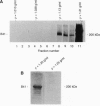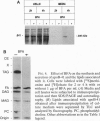Abstract
The cDNA encoding the N-terminal 41% of human apolipoprotein B (apoB), apoB-41, was transfected into nonhepatic, nonintestinal, mammary-derived mouse cells (C127) to generate stably transfected cells expressing human apoB-41 (C127B-41). As determined by centrifugation, apoB-41 is secreted exclusively on lipoproteins (LPs) having a peak density of 1.13 g/ml. Electron microscopy of apoB-41-containing LPs purified by immunoaffinity chromatography showed round particles about 12 nm in diameter. No discoidal particles were observed. Characterization of apoB-41-associated lipids after labeling C127B-41 cells with [3H]oleate and immunoprecipitating the secreted LPs with antibodies to apoB showed that 3H-labeled triacylglycerols were a major lipid class and accounted for about 54% of the total labeled lipids. Cholesterol esters and phospholipids accounted for about 6% and 22%, respectively. Incubation of cells with 0.4 mM oleate resulted in an increased incorporation of the added oleate into lipids associated with secreted apoB-41, along with a 2- to 3-fold increased secretion of apoB-41. The newly formed LPs appear to be transported through the Golgi complex, as brefeldin A (1 microgram/ml) and monensin (1 microM) greatly reduced (> 90%) the secretion of labeled apoB-41 and the amount of triacylglycerol and phospholipid associated with it. Microsomal triacylglycerol transfer protein (MTP) was not detected in these cells. Taken together, the data presented demonstrate that apoB-41 can direct the assembly and secretion of LPs that contain a triacylglycerol-rich core in nonhepatic cells that apparently lack MTP. These cells, therefore, represent an important model for studying LP assembly and may offer some advantages over cultured hepatic or intestinal cells that express their endogenous apoB gene.
Full text
PDF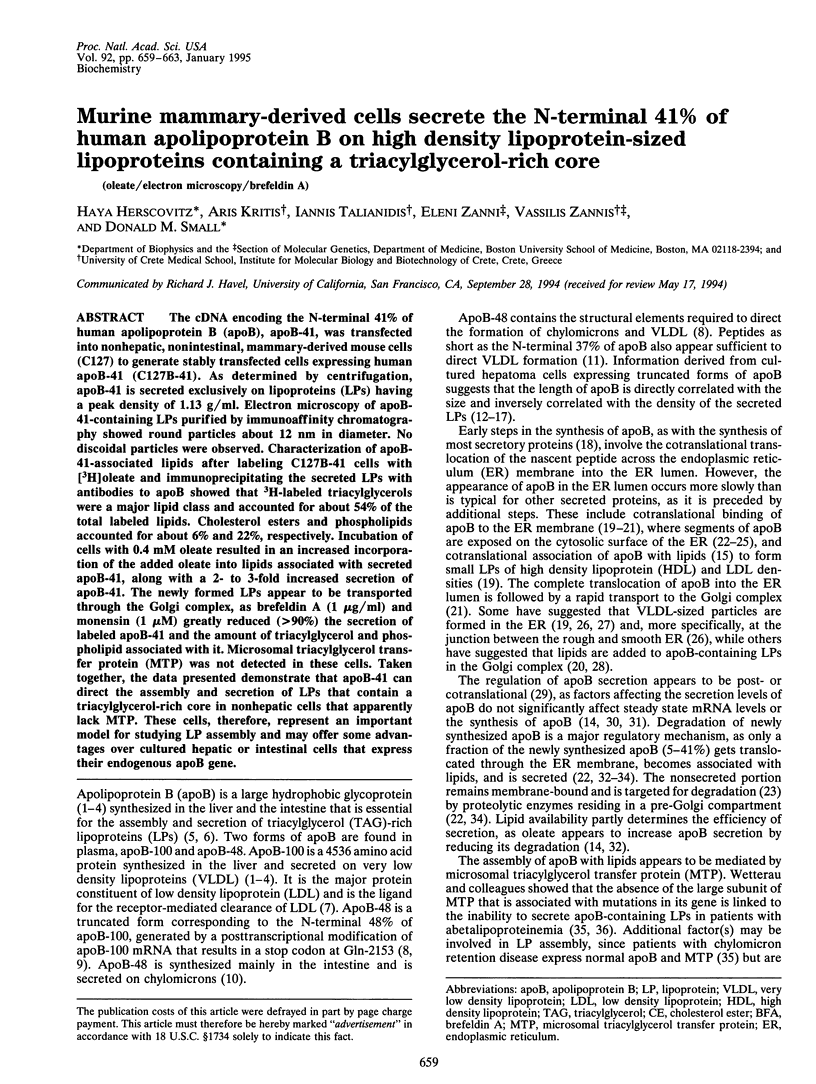
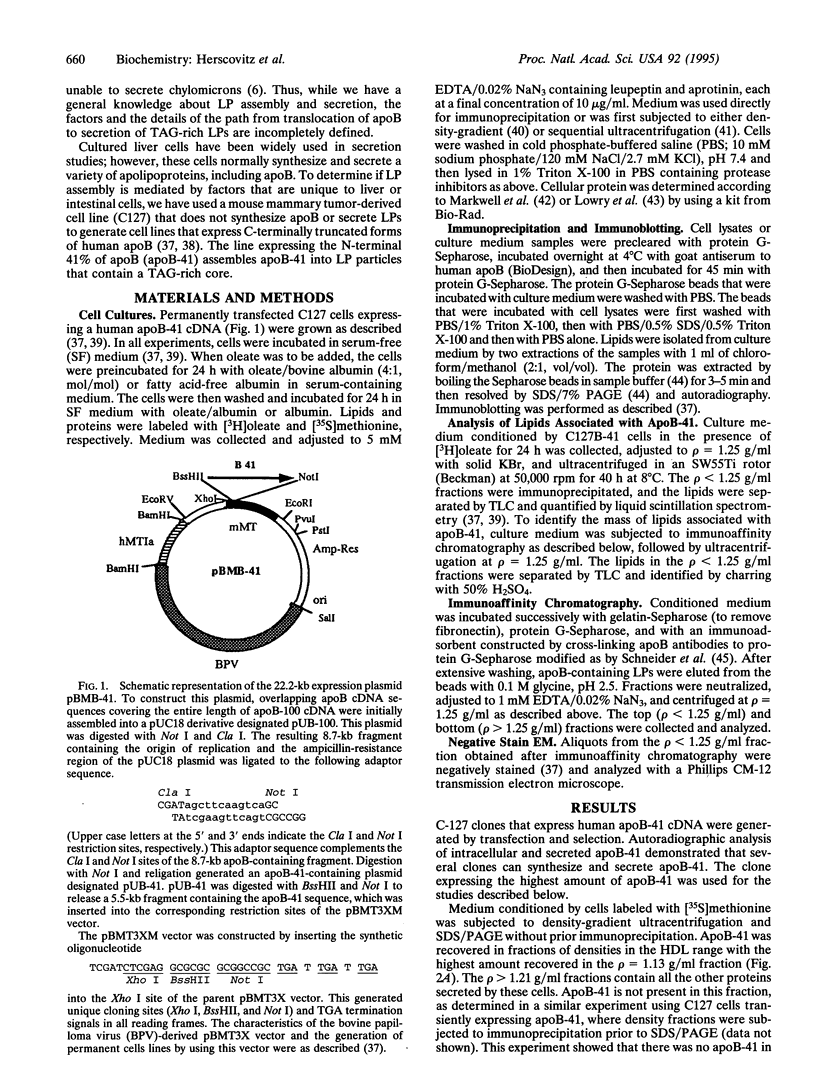
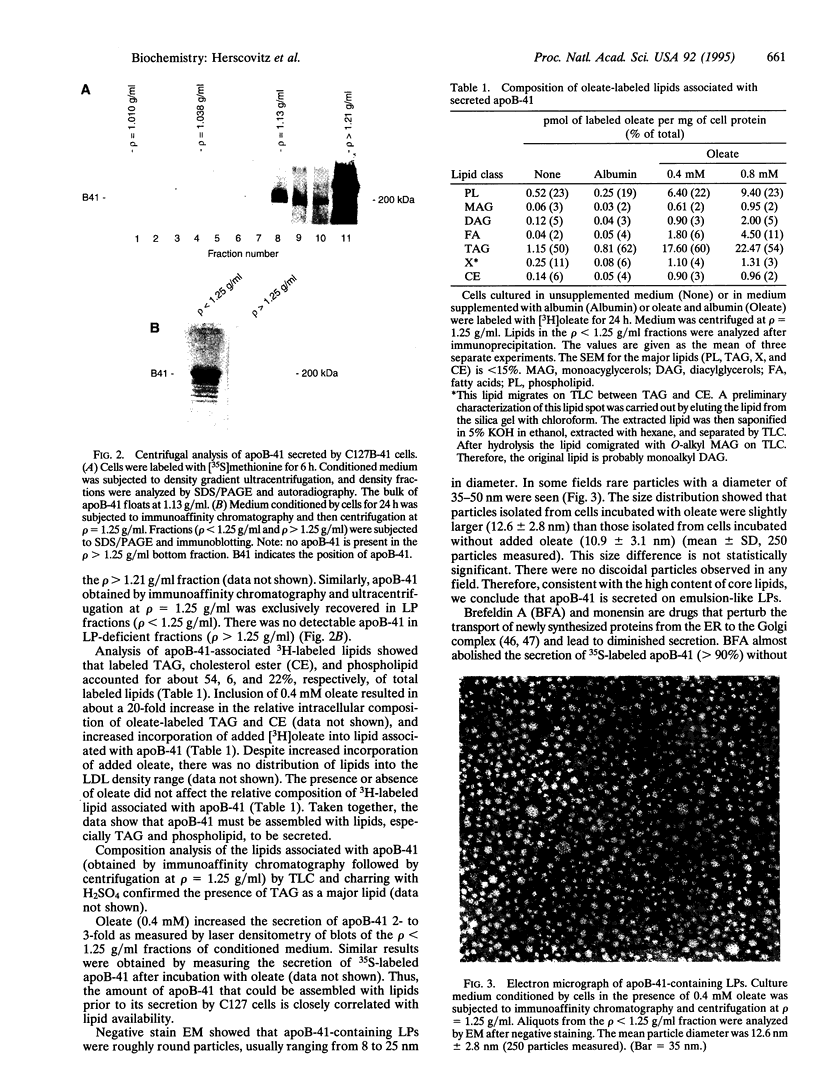
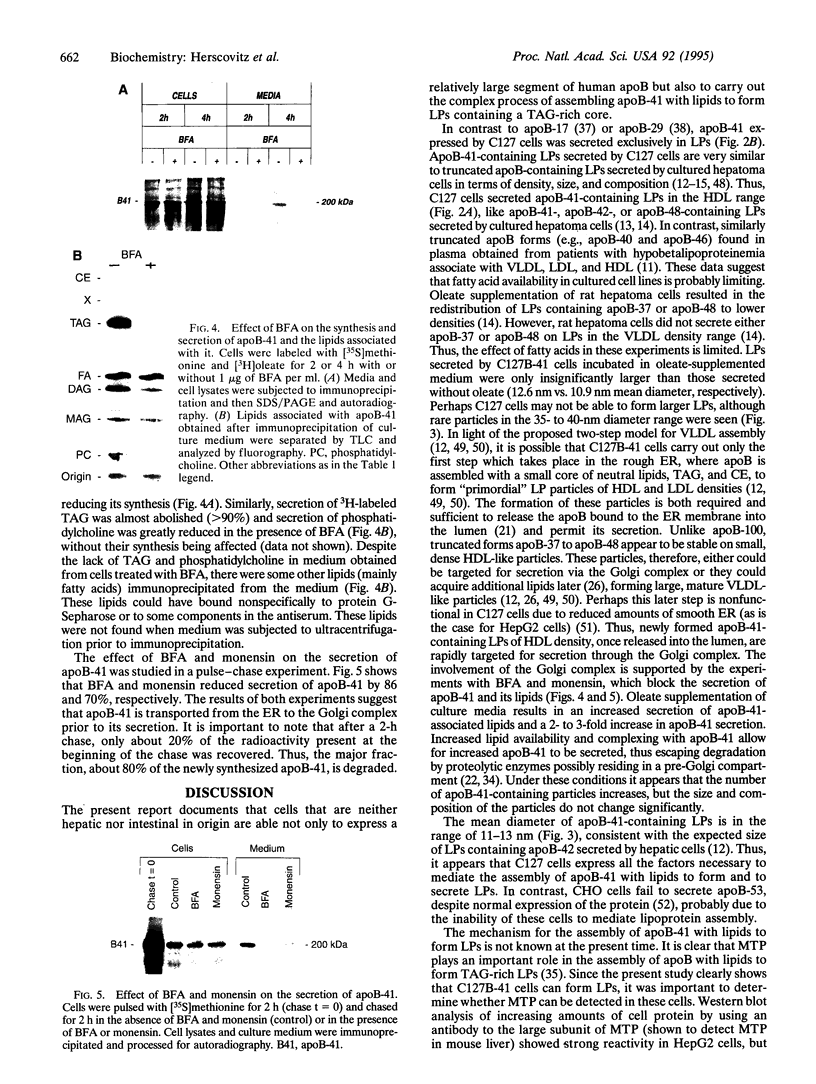
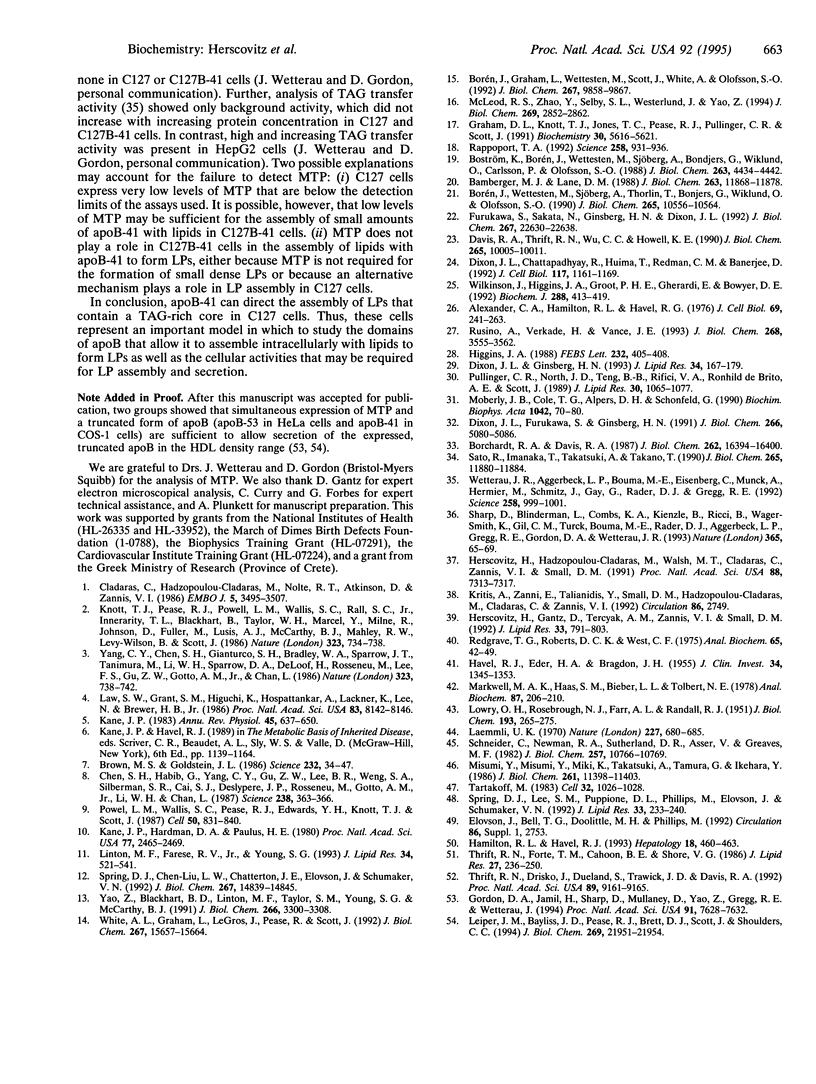
Images in this article
Selected References
These references are in PubMed. This may not be the complete list of references from this article.
- Alexander C. A., Hamilton R. L., Havel R. J. Subcellular localization of B apoprotein of plasma lipoproteins in rat liver. J Cell Biol. 1976 May;69(2):241–263. doi: 10.1083/jcb.69.2.241. [DOI] [PMC free article] [PubMed] [Google Scholar]
- Bamberger M. J., Lane M. D. Assembly of very low density lipoprotein in the hepatocyte. Differential transport of apoproteins through the secretory pathway. J Biol Chem. 1988 Aug 25;263(24):11868–11878. [PubMed] [Google Scholar]
- Borchardt R. A., Davis R. A. Intrahepatic assembly of very low density lipoproteins. Rate of transport out of the endoplasmic reticulum determines rate of secretion. J Biol Chem. 1987 Dec 5;262(34):16394–16402. [PubMed] [Google Scholar]
- Borén J., Graham L., Wettesten M., Scott J., White A., Olofsson S. O. The assembly and secretion of ApoB 100-containing lipoproteins in Hep G2 cells. ApoB 100 is cotranslationally integrated into lipoproteins. J Biol Chem. 1992 May 15;267(14):9858–9867. [PubMed] [Google Scholar]
- Borén J., Wettesten M., Sjöberg A., Thorlin T., Bondjers G., Wiklund O., Olofsson S. O. The assembly and secretion of apoB 100 containing lipoproteins in Hep G2 cells. Evidence for different sites for protein synthesis and lipoprotein assembly. J Biol Chem. 1990 Jun 25;265(18):10556–10564. [PubMed] [Google Scholar]
- Boström K., Borén J., Wettesten M., Sjöberg A., Bondjers G., Wiklund O., Carlsson P., Olofsson S. O. Studies on the assembly of apo B-100-containing lipoproteins in HepG2 cells. J Biol Chem. 1988 Mar 25;263(9):4434–4442. [PubMed] [Google Scholar]
- Brown M. S., Goldstein J. L. A receptor-mediated pathway for cholesterol homeostasis. Science. 1986 Apr 4;232(4746):34–47. doi: 10.1126/science.3513311. [DOI] [PubMed] [Google Scholar]
- Chen S. H., Habib G., Yang C. Y., Gu Z. W., Lee B. R., Weng S. A., Silberman S. R., Cai S. J., Deslypere J. P., Rosseneu M. Apolipoprotein B-48 is the product of a messenger RNA with an organ-specific in-frame stop codon. Science. 1987 Oct 16;238(4825):363–366. doi: 10.1126/science.3659919. [DOI] [PubMed] [Google Scholar]
- Cladaras C., Hadzopoulou-Cladaras M., Nolte R. T., Atkinson D., Zannis V. I. The complete sequence and structural analysis of human apolipoprotein B-100: relationship between apoB-100 and apoB-48 forms. EMBO J. 1986 Dec 20;5(13):3495–3507. doi: 10.1002/j.1460-2075.1986.tb04675.x. [DOI] [PMC free article] [PubMed] [Google Scholar]
- Davis R. A., Thrift R. N., Wu C. C., Howell K. E. Apolipoprotein B is both integrated into and translocated across the endoplasmic reticulum membrane. Evidence for two functionally distinct pools. J Biol Chem. 1990 Jun 15;265(17):10005–10011. [PubMed] [Google Scholar]
- Dixon J. L., Chattapadhyay R., Huima T., Redman C. M., Banerjee D. Biosynthesis of lipoprotein: location of nascent apoAI and apoB in the rough endoplasmic reticulum of chicken hepatocytes. J Cell Biol. 1992 Jun;117(6):1161–1169. doi: 10.1083/jcb.117.6.1161. [DOI] [PMC free article] [PubMed] [Google Scholar]
- Dixon J. L., Furukawa S., Ginsberg H. N. Oleate stimulates secretion of apolipoprotein B-containing lipoproteins from Hep G2 cells by inhibiting early intracellular degradation of apolipoprotein B. J Biol Chem. 1991 Mar 15;266(8):5080–5086. [PubMed] [Google Scholar]
- Dixon J. L., Ginsberg H. N. Regulation of hepatic secretion of apolipoprotein B-containing lipoproteins: information obtained from cultured liver cells. J Lipid Res. 1993 Feb;34(2):167–179. [PubMed] [Google Scholar]
- Furukawa S., Sakata N., Ginsberg H. N., Dixon J. L. Studies of the sites of intracellular degradation of apolipoprotein B in Hep G2 cells. J Biol Chem. 1992 Nov 5;267(31):22630–22638. [PubMed] [Google Scholar]
- Gordon D. A., Jamil H., Sharp D., Mullaney D., Yao Z., Gregg R. E., Wetterau J. Secretion of apolipoprotein B-containing lipoproteins from HeLa cells is dependent on expression of the microsomal triglyceride transfer protein and is regulated by lipid availability. Proc Natl Acad Sci U S A. 1994 Aug 2;91(16):7628–7632. doi: 10.1073/pnas.91.16.7628. [DOI] [PMC free article] [PubMed] [Google Scholar]
- Graham D. L., Knott T. J., Jones T. C., Pease R. J., Pullinger C. R., Scott J. Carboxyl-terminal truncation of apolipoprotein B results in gradual loss of the ability to form buoyant lipoproteins in cultured human and rat liver cell lines. Biochemistry. 1991 Jun 4;30(22):5616–5621. doi: 10.1021/bi00236a040. [DOI] [PubMed] [Google Scholar]
- HAVEL R. J., EDER H. A., BRAGDON J. H. The distribution and chemical composition of ultracentrifugally separated lipoproteins in human serum. J Clin Invest. 1955 Sep;34(9):1345–1353. doi: 10.1172/JCI103182. [DOI] [PMC free article] [PubMed] [Google Scholar]
- Hamilton R. L., Havel R. J. Is microsomal triglyceride transfer protein the missing link in abetalipoproteinemia? Hepatology. 1993 Aug;18(2):460–463. doi: 10.1002/hep.1840180235. [DOI] [PubMed] [Google Scholar]
- Herscovitz H., Gantz D., Tercyak A. M., Zannis V. I., Small D. M. Expression of human apolipoprotein E but not that of apolipoprotein A-I by mouse C127 cells is associated with increased secretion of lipids in the form of vesicles and discs. J Lipid Res. 1992 Jun;33(6):791–803. [PubMed] [Google Scholar]
- Herscovitz H., Hadzopoulou-Cladaras M., Walsh M. T., Cladaras C., Zannis V. I., Small D. M. Expression, secretion, and lipid-binding characterization of the N-terminal 17% of apolipoprotein B. Proc Natl Acad Sci U S A. 1991 Aug 15;88(16):7313–7317. doi: 10.1073/pnas.88.16.7313. [DOI] [PMC free article] [PubMed] [Google Scholar]
- Higgins J. A. Evidence that during very low density lipoprotein assembly in rat hepatocytes most of the triacylglycerol and phospholipid are packaged with apolipoprotein B in the Golgi complex. FEBS Lett. 1988 May 23;232(2):405–408. doi: 10.1016/0014-5793(88)80780-4. [DOI] [PubMed] [Google Scholar]
- Kane J. P. Apolipoprotein B: structural and metabolic heterogeneity. Annu Rev Physiol. 1983;45:637–650. doi: 10.1146/annurev.ph.45.030183.003225. [DOI] [PubMed] [Google Scholar]
- Kane J. P., Hardman D. A., Paulus H. E. Heterogeneity of apolipoprotein B: isolation of a new species from human chylomicrons. Proc Natl Acad Sci U S A. 1980 May;77(5):2465–2469. doi: 10.1073/pnas.77.5.2465. [DOI] [PMC free article] [PubMed] [Google Scholar]
- Knott T. J., Pease R. J., Powell L. M., Wallis S. C., Rall S. C., Jr, Innerarity T. L., Blackhart B., Taylor W. H., Marcel Y., Milne R. Complete protein sequence and identification of structural domains of human apolipoprotein B. Nature. 1986 Oct 23;323(6090):734–738. doi: 10.1038/323734a0. [DOI] [PubMed] [Google Scholar]
- LOWRY O. H., ROSEBROUGH N. J., FARR A. L., RANDALL R. J. Protein measurement with the Folin phenol reagent. J Biol Chem. 1951 Nov;193(1):265–275. [PubMed] [Google Scholar]
- Laemmli U. K. Cleavage of structural proteins during the assembly of the head of bacteriophage T4. Nature. 1970 Aug 15;227(5259):680–685. doi: 10.1038/227680a0. [DOI] [PubMed] [Google Scholar]
- Law S. W., Grant S. M., Higuchi K., Hospattankar A., Lackner K., Lee N., Brewer H. B., Jr Human liver apolipoprotein B-100 cDNA: complete nucleic acid and derived amino acid sequence. Proc Natl Acad Sci U S A. 1986 Nov;83(21):8142–8146. doi: 10.1073/pnas.83.21.8142. [DOI] [PMC free article] [PubMed] [Google Scholar]
- Leiper J. M., Bayliss J. D., Pease R. J., Brett D. J., Scott J., Shoulders C. C. Microsomal triglyceride transfer protein, the abetalipoproteinemia gene product, mediates the secretion of apolipoprotein B-containing lipoproteins from heterologous cells. J Biol Chem. 1994 Sep 2;269(35):21951–21954. [PubMed] [Google Scholar]
- Linton M. F., Farese R. V., Jr, Young S. G. Familial hypobetalipoproteinemia. J Lipid Res. 1993 Apr;34(4):521–541. [PubMed] [Google Scholar]
- Markwell M. A., Haas S. M., Bieber L. L., Tolbert N. E. A modification of the Lowry procedure to simplify protein determination in membrane and lipoprotein samples. Anal Biochem. 1978 Jun 15;87(1):206–210. doi: 10.1016/0003-2697(78)90586-9. [DOI] [PubMed] [Google Scholar]
- McLeod R. S., Zhao Y., Selby S. L., Westerlund J., Yao Z. Carboxyl-terminal truncation impairs lipid recruitment by apolipoprotein B100 but does not affect secretion of the truncated apolipoprotein B-containing lipoproteins. J Biol Chem. 1994 Jan 28;269(4):2852–2862. [PubMed] [Google Scholar]
- Misumi Y., Misumi Y., Miki K., Takatsuki A., Tamura G., Ikehara Y. Novel blockade by brefeldin A of intracellular transport of secretory proteins in cultured rat hepatocytes. J Biol Chem. 1986 Aug 25;261(24):11398–11403. [PubMed] [Google Scholar]
- Moberly J. B., Cole T. G., Alpers D. H., Schonfeld G. Oleic acid stimulation of apolipoprotein B secretion from HepG2 and Caco-2 cells occurs post-transcriptionally. Biochim Biophys Acta. 1990 Jan 16;1042(1):70–80. doi: 10.1016/0005-2760(90)90058-6. [DOI] [PubMed] [Google Scholar]
- Powell L. M., Wallis S. C., Pease R. J., Edwards Y. H., Knott T. J., Scott J. A novel form of tissue-specific RNA processing produces apolipoprotein-B48 in intestine. Cell. 1987 Sep 11;50(6):831–840. doi: 10.1016/0092-8674(87)90510-1. [DOI] [PubMed] [Google Scholar]
- Pullinger C. R., North J. D., Teng B. B., Rifici V. A., Ronhild de Brito A. E., Scott J. The apolipoprotein B gene is constitutively expressed in HepG2 cells: regulation of secretion by oleic acid, albumin, and insulin, and measurement of the mRNA half-life. J Lipid Res. 1989 Jul;30(7):1065–1077. [PubMed] [Google Scholar]
- Rapoport T. A. Transport of proteins across the endoplasmic reticulum membrane. Science. 1992 Nov 6;258(5084):931–936. doi: 10.1126/science.1332192. [DOI] [PubMed] [Google Scholar]
- Redgrave T. G., Roberts D. C., West C. E. Separation of plasma lipoproteins by density-gradient ultracentrifugation. Anal Biochem. 1975 May 12;65(1-2):42–49. doi: 10.1016/0003-2697(75)90488-1. [DOI] [PubMed] [Google Scholar]
- Rusiñol A., Verkade H., Vance J. E. Assembly of rat hepatic very low density lipoproteins in the endoplasmic reticulum. J Biol Chem. 1993 Feb 15;268(5):3555–3562. [PubMed] [Google Scholar]
- Sato R., Imanaka T., Takatsuki A., Takano T. Degradation of newly synthesized apolipoprotein B-100 in a pre-Golgi compartment. J Biol Chem. 1990 Jul 15;265(20):11880–11884. [PubMed] [Google Scholar]
- Schneider C., Newman R. A., Sutherland D. R., Asser U., Greaves M. F. A one-step purification of membrane proteins using a high efficiency immunomatrix. J Biol Chem. 1982 Sep 25;257(18):10766–10769. [PubMed] [Google Scholar]
- Sharp D., Blinderman L., Combs K. A., Kienzle B., Ricci B., Wager-Smith K., Gil C. M., Turck C. W., Bouma M. E., Rader D. J. Cloning and gene defects in microsomal triglyceride transfer protein associated with abetalipoproteinaemia. Nature. 1993 Sep 2;365(6441):65–69. doi: 10.1038/365065a0. [DOI] [PubMed] [Google Scholar]
- Spring D. J., Chen-Liu L. W., Chatterton J. E., Elovson J., Schumaker V. N. Lipoprotein assembly. Apolipoprotein B size determines lipoprotein core circumference. J Biol Chem. 1992 Jul 25;267(21):14839–14845. [PubMed] [Google Scholar]
- Spring D. J., Lee S. M., Puppione D. L., Phillips M., Elovson J., Schumaker V. N. Identification of a neutral lipid core in a transiently expressed and secreted lipoprotein containing an apoB-48-like apolipoprotein. J Lipid Res. 1992 Feb;33(2):233–240. [PubMed] [Google Scholar]
- Tartakoff A. M. Perturbation of vesicular traffic with the carboxylic ionophore monensin. Cell. 1983 Apr;32(4):1026–1028. doi: 10.1016/0092-8674(83)90286-6. [DOI] [PubMed] [Google Scholar]
- Thrift R. N., Drisko J., Dueland S., Trawick J. D., Davis R. A. Translocation of apolipoprotein B across the endoplasmic reticulum is blocked in a nonhepatic cell line. Proc Natl Acad Sci U S A. 1992 Oct 1;89(19):9161–9165. doi: 10.1073/pnas.89.19.9161. [DOI] [PMC free article] [PubMed] [Google Scholar]
- Thrift R. N., Forte T. M., Cahoon B. E., Shore V. G. Characterization of lipoproteins produced by the human liver cell line, Hep G2, under defined conditions. J Lipid Res. 1986 Mar;27(3):236–250. [PubMed] [Google Scholar]
- Wetterau J. R., Aggerbeck L. P., Bouma M. E., Eisenberg C., Munck A., Hermier M., Schmitz J., Gay G., Rader D. J., Gregg R. E. Absence of microsomal triglyceride transfer protein in individuals with abetalipoproteinemia. Science. 1992 Nov 6;258(5084):999–1001. doi: 10.1126/science.1439810. [DOI] [PubMed] [Google Scholar]
- White A. L., Graham D. L., LeGros J., Pease R. J., Scott J. Oleate-mediated stimulation of apolipoprotein B secretion from rat hepatoma cells. A function of the ability of apolipoprotein B to direct lipoprotein assembly and escape presecretory degradation. J Biol Chem. 1992 Aug 5;267(22):15657–15664. [PubMed] [Google Scholar]
- Wilkinson J., Higgins J. A., Groot P. H., Gherardi E., Bowyer D. E. Determination of the intracellular distribution and pool sizes of apolipoprotein B in rabbit liver. Biochem J. 1992 Dec 1;288(Pt 2):413–419. doi: 10.1042/bj2880413. [DOI] [PMC free article] [PubMed] [Google Scholar]
- Yang C. Y., Chen S. H., Gianturco S. H., Bradley W. A., Sparrow J. T., Tanimura M., Li W. H., Sparrow D. A., DeLoof H., Rosseneu M. Sequence, structure, receptor-binding domains and internal repeats of human apolipoprotein B-100. Nature. 1986 Oct 23;323(6090):738–742. doi: 10.1038/323738a0. [DOI] [PubMed] [Google Scholar]
- Yao Z. M., Blackhart B. D., Linton M. F., Taylor S. M., Young S. G., McCarthy B. J. Expression of carboxyl-terminally truncated forms of human apolipoprotein B in rat hepatoma cells. Evidence that the length of apolipoprotein B has a major effect on the buoyant density of the secreted lipoproteins. J Biol Chem. 1991 Feb 15;266(5):3300–3308. [PubMed] [Google Scholar]



